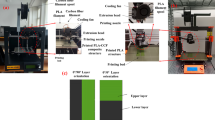Abstract
Welding sequence has a significant effect on distortion pattern of large orthogonally stiffened panels normally used in ships and offshore structures. These deformations adversely affect the subsequent fitup and alignment of the adjacent panels. It may also result in loss of structural integrity. These panels primarily suffer from angular and buckling distortions. The extent of distortion depends on several parameters such as welding speed, plate thickness, welding current, voltage, restraints applied to the job while welding, thermal history as well as sequence of welding. Numerical modeling of welding and experimental validation of the FE model has been carried out for estimation of thermal history and resulting distortions. In the present work an FE model has been developed for studying the effect of welding sequence on the distortion pattern and its magnitude in fabrication of orthogonally stiffened plate panels.
Similar content being viewed by others
References
Adak M, Mandal NR (2003). Thermo-mechanical analysis through a Pseudo-linear equivalent constant stiffness system. Journal of Engineering for the Maritime Environment, 217(M1), 1–9.
Alberg H (2005). Simulation of welding and heat treatment modelling and validation. PhD thesis, Lulea University of Technology, Sweden.
Biswas P, Mandal NR, Sha OP (2006). Numerical and ANN prediction of thermal history of submerged arc welding. Journal of Mechanical Behavior of Materials, 17(4), 269–286.
Biswas P, Mandal NR, Sha OP (2007). Prediction of process parameters of line heating process by three dimensional finite element method. Proc.IMechE, J. Engineering for the Maritime Environment, 221(Part M), 17–30.
Biswas P, Mandal NR (2008). Welding distortion simulation of large stiffened plate panels. Journal of Ship Production, 24(1), 50–56.
Bonifaz E (2000). Finite element analysis of heat flow in single-pass arc welds. Welding Research Supplements, May, 121–125.
Brown S, Song H (1992). Implication of three-dimensional numerical simulations of welding large structures. Weld. J., 71(2), 55s–62s.
Cheng W (2005). In-plane shrinkage strains and their effects on welding distortion in thin-wall structures. PhD thesis, The Ohio State University, USA.
Depradeux L, Jullien JF (2004). Experimental and numerical simulation of thermomechanical phenomena during a TIG welding process. J. Physic. IV France, 120, 697–704.
Fanous FZ. Ihab, Younan Maher YA, Wifi, S A (2003). 3-D Finite element modelling of the welding process using element birth and element movement techniques. Tran. ASME, J. Pressure Vessel Technol., 125, 144–150.
Friedman E (1975). Thermo mechanical analysis of the welding process using the finite element method. Transaction of ASME, 206–213.
Kamala V, Goldak J. A (1993). Error due to two dimensional approximation in heat transfer analysis of welds. Weld. J., 72(9), 440s–446s.
Mandal NR, Adak M (2001). Fusion zone and HAZ prediction through 3-D simulation of welding thermal cycle. Journal of the Mechanical Behavior of Materials, 12(6), 401–414.
Michaleris P, Debiccari A (1997). Prediction of welding distortion. Welding Journal, April, 172–180.
Okada A (1977). Application of melting efficiency and its problems. Journal of Japan Welding Society, 46, 53–61.
Rao PN (1998). Manufacturing technology. Tata McGraw-Hill Pub. Co. Ltd., New Delhi.
Teng TL, Fung CP, Chang PH, Yang WC (2001). Analysis of residual stresses and distortions in T-joint fillet welds. International Journal of Pressure Vessels and Piping, 78, 523–538.
Tekriwal P, Mazumdar J (1988). Finite element analysis of three dimensional heat transfer in gas manual arc welding. Welding Research Supplement, Welding Journal, July, 150–156.
Watanbe M, Satoh K (1961). Effect of welding conditions on the shrinkage and distortion in welded structures. Weld. J., 40(8), 377s–384s.
Yu G, Anderson RJ, Maekawa T, Patrikalakis NM (2001). Efficient simulation of shell forming by line heating. Journal of Mechanical Sciences, 43, 2349–2370.
Author information
Authors and Affiliations
Corresponding author
Additional information
Dr. Pankaj Biswas was born in 1979. He is an Assistant Professor of IIT Guwahati, Dept. of Mechanical Eng. His current research interests include manufacturing and design: computational weld mechanics, ship production, line heating, and FE structural analysis.
Mr. D. Anil Kumar was born in 1983. He is a Research Scholar of IIT Guwahati, Dept. of Mechanical Eng. His current research interests include manufacturing: computational weld mechanics and FE thermo mechanical analysis.
Dr. Nisith Ranjan Mandal was born in 1954. He is a professor of IIT Kharagpur, Dept. of OE&NA. His current research interests include ship production, ship design, line heating, welding distortion of large stiffened structures and welding techniques.
Dr. M. M. Mahapatra was born in 1970. He is working as an assistant professor in the Mechanical and Industrial Engineering Department at Indian Institute of Technology, Roorkee. His current research interests include plate forming by line heating, welding deformation, welding residual stress analysis, and design of welded structures.
Rights and permissions
About this article
Cite this article
Biswas, P., Kumar, D.A., Mandal, N.R. et al. A study on the effect of welding sequence in fabrication of large stiffened plate panels. J. Marine. Sci. Appl. 10, 429–436 (2011). https://doi.org/10.1007/s11804-011-1088-8
Received:
Published:
Issue Date:
DOI: https://doi.org/10.1007/s11804-011-1088-8




